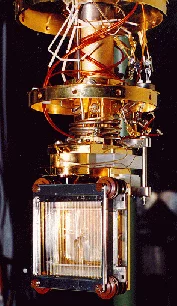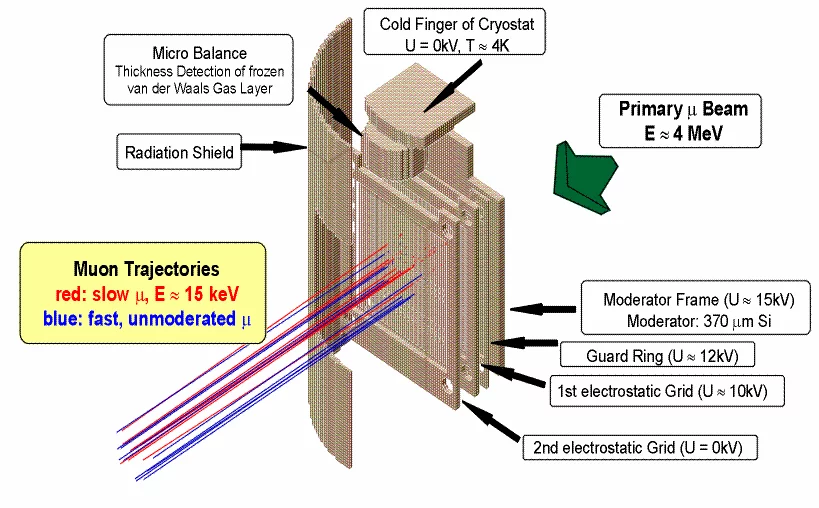The Moderation Process
A moderator is to some extent a very specialized degrader. Differently from a degrader, a moderator is able to deliver a source of thermal or epithermal (a few eV) particles by efficiently converting high energy particles into thermal or epithermal particles. It relies on specific properties of the interaction and of the transport of thermal or epithermal particles in appropriate solids leading to an unusual large emission probability of particles slowed down in these materials. At the moment, the most efficient moderators are made of a few hundred nm thick solid rare gas or solid nitrogen films deposited on a cold (~10 K) substrate. We use 370-µm Si wafers or 125-µm Ag foils as substrates. The moderation probability per incoming muon is between 10-5 and 10-4, depending on the surface muon beam momentum bite and the moderator gas.
As a source for epithermal (~15 eV) muons a secondary beam line is tuned to a momentum of 27.5 MeV/c. These surface muons have a polarization of nearly 100%. A high polarization is an important requirement for the application of low-energy muons in µSR investigations. Our measurements showed the conservation of the polarization during the moderation process. The beam momentum is determined by requiring the maximum stop density in the thin solid gas layer on the downstream side of the substrate, which translates into the maximum yield of epithermal muons emerging from the moderator. The main part of the moderation process consists of degrading a fraction of the beam in the substrate to energies of a few tens of keV by ordinary ionization processes. These keV muons are further decelerated when passing through the solid gas layer. At energies below a few keV charge-exchange processes are the dominant inelastic processes. However, at energies below ~50 eV the corresponding cross sections are decreasing rapidly and there opens an energy window where inelastic energy loss is strongly suppressed. Since the frozen gas layers are weakly bound van der Waals solids there are - to first approximation - no other efficient inelastic energy loss processes present. So, once the muon reaches epithermal energies in the solid moderator layer (and the muon did not form muonium) it can move through the solid without efficient energy loss, which causes the large, measured escape depth of up to 100 nm. This is a direct manifestation of the strongly reduced electronic stopping power in these special systems. The elastic energy loss due to collisions with the nuclei is small because the muon is much lighter than the nuclei. The elastic collisions mainly cause a change in direction of the muon momentum. Since there are many elastic collisions at epithermal energies when moving through a path of ~100 nm, the angular distribution of the epithermal muons becomes isotropic before leaving the layer. This is in agreement with our data which are consistent with cos(Theta) distribution of the exiting epithermal muons.
The moderation process in the solid gas layers leads to a very strong enhancement of emitted muons with a mean energy of ~15 eV, compared to any other materials which only act as a degrader showing a flat energy spectrum down to zero energy. The energy spectrum of the epithermal muons is smeared out with a FWHM of ~20 eV. Due to the small thickness of ~100 nm of the "active" moderator only a small fraction of the beam can be converted to epithermal muons. This fraction is further reduced by the ~80% probability (for Ar and N2, and even higher for Kr and Xe) that the muon reaches epithermal energies as muonium and thermalizes or leaves the layer as muonium. The dominant fraction of the beam exits the moderator target as "fast" (degraded, not moderated) muons with a mean energy of 500 keV and a FWHM of the same order.
As a source for epithermal (~15 eV) muons a secondary beam line is tuned to a momentum of 27.5 MeV/c. These surface muons have a polarization of nearly 100%. A high polarization is an important requirement for the application of low-energy muons in µSR investigations. Our measurements showed the conservation of the polarization during the moderation process. The beam momentum is determined by requiring the maximum stop density in the thin solid gas layer on the downstream side of the substrate, which translates into the maximum yield of epithermal muons emerging from the moderator. The main part of the moderation process consists of degrading a fraction of the beam in the substrate to energies of a few tens of keV by ordinary ionization processes. These keV muons are further decelerated when passing through the solid gas layer. At energies below a few keV charge-exchange processes are the dominant inelastic processes. However, at energies below ~50 eV the corresponding cross sections are decreasing rapidly and there opens an energy window where inelastic energy loss is strongly suppressed. Since the frozen gas layers are weakly bound van der Waals solids there are - to first approximation - no other efficient inelastic energy loss processes present. So, once the muon reaches epithermal energies in the solid moderator layer (and the muon did not form muonium) it can move through the solid without efficient energy loss, which causes the large, measured escape depth of up to 100 nm. This is a direct manifestation of the strongly reduced electronic stopping power in these special systems. The elastic energy loss due to collisions with the nuclei is small because the muon is much lighter than the nuclei. The elastic collisions mainly cause a change in direction of the muon momentum. Since there are many elastic collisions at epithermal energies when moving through a path of ~100 nm, the angular distribution of the epithermal muons becomes isotropic before leaving the layer. This is in agreement with our data which are consistent with cos(Theta) distribution of the exiting epithermal muons.
The moderation process in the solid gas layers leads to a very strong enhancement of emitted muons with a mean energy of ~15 eV, compared to any other materials which only act as a degrader showing a flat energy spectrum down to zero energy. The energy spectrum of the epithermal muons is smeared out with a FWHM of ~20 eV. Due to the small thickness of ~100 nm of the "active" moderator only a small fraction of the beam can be converted to epithermal muons. This fraction is further reduced by the ~80% probability (for Ar and N2, and even higher for Kr and Xe) that the muon reaches epithermal energies as muonium and thermalizes or leaves the layer as muonium. The dominant fraction of the beam exits the moderator target as "fast" (degraded, not moderated) muons with a mean energy of 500 keV and a FWHM of the same order.
The Moderation Target
For the extraction of the epithermal muons from the moderator region an opening in the radiation shields of the cryostat is left at the downstream side. Therefore, the substrate is exposed to thermal radiation and the material for the substrate must have a good heat conductivity at low temperatures in order to be cooled to T < 20 K. This temperature is necessary for stable argon or nitrogen layers under UHV conditions.
Another important factor is the stopping density of the muon beam in the substrate and the moderator layer. A Monte-Carlo simulation shows an increasing stopping density in the substrate with increasing atomic number Z (and density). Although the density of the solid gas layer is lower than for most of the possible metal substrates, the stopping density in the solid gas layer also increases with increasing Z of the substrate material. However, for high Z elements like gold - having the highest stopping densities - there is also an increasing fraction of backscattered muons which cause a decrease of stopping density in the moderator layer. Therefore, medium Z elements like copper or silver appears to be best suited as a substrate.
The isotropic momentum distribution of epithermal muons in the moderator leads to a higher epithermal muon yield in vacuum when simply increasing the "active" volume of the moderator. This can be done by increasing the surface of the substrate. It was first tested with a silicon grating substrate where a well defined structure can easily be grown by photolithography. The measured gain (compared to a flat substrate) of 1.6(1) of the epithermal muon yield corresponds well to the surface enlargment factor of 1.7. In a second step the silicon grating is replicated into an annealed, high purity silver foil by embossing it with forces of 100 t. The structured silver substrate with moderator layer yields another 15% increase in epithermal muon flux as expected from the higher stopping densities.
Once the muons are slowed down and exiting the moderator at epithermal energies they must be separated from the dominant fraction of fast muons and focused to the sample area. This is done by an electrostatic transport system. The first part consists of an electrostatic accelerator with the moderator itself set to high voltages of up to +20 kV. The electric field in the accelerator is defined by a guard ring and two grid planes mounted at the downstream side with the last grid on ground potential. The guard ring and the first grid are floated between moderator and ground potential to obtain the best muon extraction. In this way the maximum energy of the reaccelerated muons amounts to 20 keV with a small energy spread of 20 eV.
The isotropic momentum distribution of epithermal muons in the moderator leads to a higher epithermal muon yield in vacuum when simply increasing the "active" volume of the moderator. This can be done by increasing the surface of the substrate. It was first tested with a silicon grating substrate where a well defined structure can easily be grown by photolithography. The measured gain (compared to a flat substrate) of 1.6(1) of the epithermal muon yield corresponds well to the surface enlargment factor of 1.7. In a second step the silicon grating is replicated into an annealed, high purity silver foil by embossing it with forces of 100 t. The structured silver substrate with moderator layer yields another 15% increase in epithermal muon flux as expected from the higher stopping densities.
Once the muons are slowed down and exiting the moderator at epithermal energies they must be separated from the dominant fraction of fast muons and focused to the sample area. This is done by an electrostatic transport system. The first part consists of an electrostatic accelerator with the moderator itself set to high voltages of up to +20 kV. The electric field in the accelerator is defined by a guard ring and two grid planes mounted at the downstream side with the last grid on ground potential. The guard ring and the first grid are floated between moderator and ground potential to obtain the best muon extraction. In this way the maximum energy of the reaccelerated muons amounts to 20 keV with a small energy spread of 20 eV.

